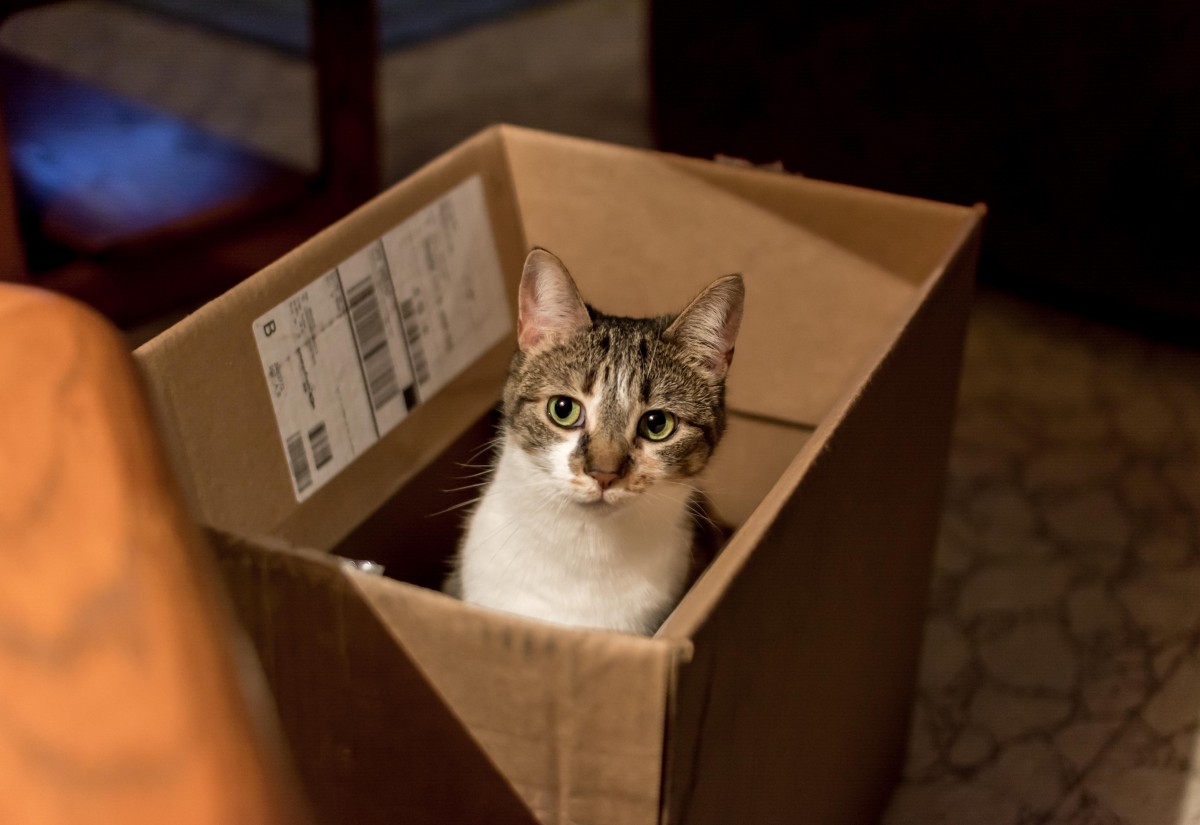
Though we at DFC are avowed dog people (and today is Jill’s birthday), there are folks in our lives who are strictly Team Cat when it comes to at-home companions. And, like  most of the internet, they will not stop talking about the doofy things their indoor felines do on a daily basis — like get brain freeze, startle at cucumbers, and give in to a mysterious force that compels them to jump into boxes. (I’m looking at you, Maru)
most of the internet, they will not stop talking about the doofy things their indoor felines do on a daily basis — like get brain freeze, startle at cucumbers, and give in to a mysterious force that compels them to jump into boxes. (I’m looking at you, Maru)
Now I’m biased: as a dog owner, I believe there is nothing more majestic than a canine chasing after a groundhog through the tall grass of a field. But it turns out that Maru and friends are not just being cute — they’re hunting. They are exhibiting exactly the same noble behaviour as the irrepressible Jill, but they’re just doing it in their own way, and (big difference) indoors.
Via the always-wondrous BoingBoing comes a fascinating video starring Abigail Tucker, author of The Lion in the Living Room, and contextualizer of housecat behaviour. In it, she analyzes the adorable kitty who can’t help invading the box your Amazon purchase just came in. Cats are not particularly well suited to confined living, and will often engage in cute-to-annoying behaviours (scratching, running around madly at 3 am) out of boredom. Cats jump into boxes due to an evolutionary memory as well: in an effort to ambush prey (read: their favourite nip-stuffed toy) the same way they did for eons in the wild. Unlike a canine, a cat does not chase, and a box provides a compact, secluded base of operations for it to play to its strengths.
Tucker further explains that fifty years ago, we would not have seen as much of this box-jumping behaviour, because cats only really came into prominence as domestic pets around that time. Before then, they would have prowled backyards or earned their keep by patrolling for mice in a barn. This is not to say that it’s better for a cat to be based outdoors! Sure, they won’t be bored, but they’ll face danger and injury, and an average lifespan of only two to five years. Give your indoor cat lots of mental stimulation, good food, and exercise, and they will have 18 to 20 years to do all kinds of weird stuff you can then post on YouTube!

In a proof-of concept study, researchers at Chonnam National University in South Korea have bioengineered a strain of Salmonella that can enter tumours and, Trojan-Horse-style, trigger the host’s immune system to attack the malignant cells. So far, this works well in mice, but the team is hoping this early success will pave the way for human trials.
Bacteria naturally have great tumour-radar, which makes them ripe for use in cancer therapies. In this expereiment:
“[…] the Salmonella bacteria is genetically modified to secrete a foreign protein known as flagellin (FlaB). This protein, found in an aquatic microbe called Vibrio vulnificus, is the building block of flagellum—the lash-like appendage that allows microorganisms to swim around. Since vertebrate animals, including humans, don’t have a flagellum, this protein is foreign to our cells. When voracious white blood cells known as macrophages detect the presence of these foreign proteins, they immediately sense danger and spring into action.
Macrophages are like microscopic Roombas, vacuuming anything that doesn’t look like it’s supposed to be there, including bits of cellular debris, unfamiliar substances, viruses, unwanted bacteria, and importantly, cancer cells.”
Bacterial therapy for cancer is experiencing a resurgence, after spending most of the 20th century in the shadow of radiotherapy and chemotherapy. The researchers propose someday using all three methods together, for a three-pronged attack on tumours.
I really enjoy the symmetry here, that the food poisoning bacteria everyone loves to hate may someday be used against the just-plain-hated scourge of cancer! Where the microbiome is concerned, the wonders truly never cease.

European snail farmers are currently experiencing an unheard-of demand for their product. Interestingly, it’s not in response to an uptick in escargot consumption, the usual fate of Helix aspersa or Cornu aspersum, but in a cosmetics fad for snail slime skin serums.
Studies have shown that the uniquely thick mucus produced by these snails can help regenerate skin. This has led to massive interest in a formerly niche ingredient in skincare creams, and a surge in production at the many (often Italian) farms where these snails are bred.
While staying on top of this lucrative trend, farmers have developed a gentler slime harvesting process, which keeps the snails happier and more productive (in the mucus-y definition):
“To force snails to secrete slime, traditionally they were dunked in pots of water with salt, vinegar or other chemicals. […]
Italy’s International Heliciculture Association recently patented a new machine, called the Muller One, which extracts snail slime by immersing the creatures in a special steam bath.
‘It is essentially a spa for snails,’ said [president of the Association Simone] Sampo. ‘We raise them naturally, feed them only vegetable matter and then extract the slime with water that contains ozone, which kills all the bacteria. The snails are not harmed.’”
It’s no secret that I love nature, and I’m especially interested in conservation. So I’m thrilled to see that these tiny creatures — so different from us it can be hard to have empathy — are being treated with conscience in this arrangement, and even being pampered! It’s a fair trade-off, I think, for the pampering their goop provides for us.
Some great new tech news from my favourite innovators, those wacky folks at MIT: they’ve invented a series of hydrogel “robots,” which are much more responsive than previous generations, and could have an extraordinary range of applications in the medical field and beyond!
These soft robots are designed to “live” and work in water. The designs include a fin that waves, an articulated finger that can kick outward, and a hand-shaped construction that can gently grab small objects. The chief new innovation involves pumping water into the structures quickly, rather than relying on natural absorption. This allows the fin, finger, and especially the hand, to move faster and apply greater force to what they are trying to affect. The team offered a particularly cool demonstration video in which the hand robot grasped and release a goldfish so quickly and gently, that the goldfish was barely disturbed!
These robots are rough-and-tough too, and are effectively invisible — benefits for both medical and underwater applications:
“‘Hydrogels are soft, wet, biocompatible, and can form more friendly interfaces with human organs, [MIT associate professor of mechanical engineering and civil and environmental engineering Xuanhe] Zhao says. ‘We are actively collaborating with medical groups to translate this system into soft manipulators such as hydrogel “hands,” which could potentially apply more gentle manipulations to tissues and organs in surgical operations. […]
For the past five years, Zhao’s group has been developing ‘recipes’ for hydrogels, mixing solutions of polymers and water, and using techniques they invented to fabricate tough yet highly stretchable materials. They have also developed ways to glue these hydrogels to various surfaces such as glass, metal, ceramic, and rubber, creating extremely strong bonds that resist peeling.”
The team also mentions that other potential applications for these robots may not have even been thought of yet, and they are “tossing this concept out there” to see what the rest of the community might come up with. The spirit of collaboration at its finest! I’m very intrigued to see where these little guys go, and I for one welcome our tiny, invisible, fish-hugging overlords.
To the pantheon of adorable robots, Georgia Tech’s Centre for Music technology is making a bid to add a little fellow named Shimon. With one large lens for a friendly eye and four mallets in hand, Shimon is a demon on the marimba. But while rocking out with the best improvisational jazz musicians, he also shows through mimicry how humans read each other in order to make art.
Shimon can improvise with human musicians by “listening” to them, and following programming to select appropriate complementary beats and notes. But, above and beyond your standard music-generating robot, he also takes in and reflects back particular social cues.
“When you watch a band perform on stage and you observe the guitar player and the drummer synchronizing their movements, you’re actually witnessing an important part of musicianship. […] Body movement, gestures and physical interaction tell musicians how to play their instruments.
[…]Shimon’s intelligence includes an ‘interestingness’ algorithm, where interesting is defined by music that is different from what other players are playing or different from music Shimon heard earlier in a song.
‘And when it does this, he’ll look at you, just like a musician would when you’re playing together, and you do something that was a little off or different,’ [creator Professor Gil] Weinberg said.”
Musicians who jam with Shimon report treating him like a peer: wanting to catch his gaze and while performing and feeling connected to the group as a result.
Beyond the coolness factor, Shimon illustrates how easy it is for a robot to foster human emotional connection. All it takes is a few physical gestures in recognizable shapes, and we fill in the rest. Shimon embodies artistic application, but I could totally see the same principle applied to household helper robots, or even sales robots. Of course, when we get that far…!